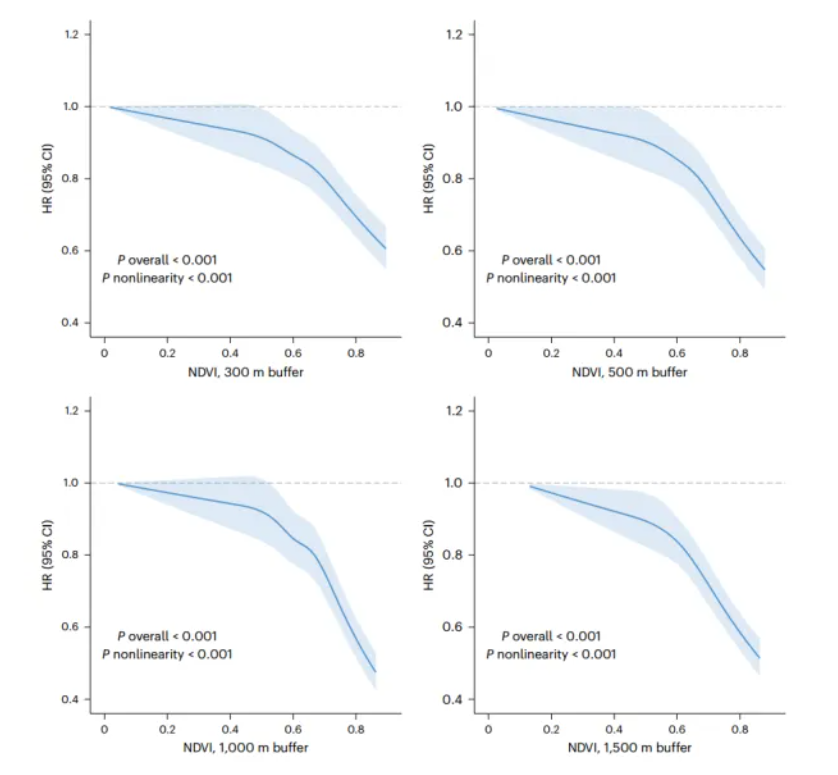文章来源:Wang J, Ma Y, Tang L, et al. (2024). Long-term exposure to residential greenness and decreased risk of depression and anxiety. Nature Mental Health. https://doi.org/10.1038/s44220-024-00227-z.
整理人:徐嘉苗,2021级本科生
整理时间:2024年5月4日
Abstract: Residential greenness is considered a unique and potentially modifiable exposure construct to reduce physiological stress and improve human health. Here this study aims to investigate the longitudinal relationships of residential greenness with incident depression and anxiety and to explore and compare the pathways in which greenery may influence mental health. After excluding participants with depression or anxiety at baseline, a family history of severe depression, loss to follow-up or missing information on greenness exposure, we analyzed data of 409,556 participants from the UK Biobank. Residential greenness was assessed utilizing the normalized difference vegetation index (NDVI) within a buffer region of 300 m, 500 m, 1,000 m and 1,500 m. Incident depression and anxiety cases were identified by linking to records on the death register, hospital admissions, primary care and self-report. Time-varying Cox proportional hazards models were used to analyze the associations between greenness and incident depression and anxiety. During a median follow-up of 11.9 years, 14,309 (3.5%, 306.9/100,000 person-years) and 16,692 (4.1%, 358.0/100,000 person-years) patients were diagnosed with depression and anxiety, respectively. The hazard ratios and 95% confidence intervals (CIs) for depression and anxiety were 0.84 (95% CI, 0.82–0.85 and P < 0.001) and 0.86 (95% CI, 0.84–0.87 and P < 0.001) in the highest quartile compared with the lowest quartile of NDVI 300 m, respectively. Similar trends were shown for NDVI 500 m, 1,000 m and 1,500 m. Air pollution (particulate matter with an aerodynamic diameter of 2.5 μm or less (PM2.5), NO2, NOx, SO2 and O3) played a major mediator role in the associations. For example, the association between NDVI 300 m and depression was 52.9% (95% CI, 31.6–73.1%), 28.4% (95% CI, 13.4–50.3%), 30.9% (95% CI, 17.8–48.1%), 2.4% (95% CI, 1.4–4.1%) and 27.7% (95% CI, 19.4–37.9%) mediated by the reduced PM2.5, NO2, NOx, SO2 and O3, respectively. This national study highlights that long-term exposure to residential greenness was linked to a decreased risk of incident depression and anxiety. Reduced air pollution was a significant mediator linking green environments to depression and anxiety.
摘要:住宅绿化被认为是一种独特的可修改的暴露结构,可以减少生理压力和改善人类健康。本研究旨在探讨绿化与抑郁和焦虑的纵向关系,并探究和对比绿化对心理健康的影响途径。在排除了基线时患有抑郁或焦虑、有严重抑郁家族史、缺乏随访或缺乏绿色暴露信息的参与者后,我们分析了来自英国生物银行的409,556名参与者的数据。利用归一化植被指数(NDVI)对300 m、500 m、1000 m和1500 m缓冲区内的住宅绿化度进行了评估。通过与死亡登记、住院情况、初级保健和自我报告的记录相联系,确定了偶发性抑郁和焦虑病例。采用时变Cox比例风险模型分析绿化与事件抑郁和焦虑之间的关系。在中位11.9年的随访期间,分别有14,309(3.5%,306.9/100,000人年)和16,692(4.1%,358.0/100,000人年)患者被诊断为抑郁症和焦虑症。与NDVI 300 m的最低四分位数相比,抑郁和焦虑的最高四分位数的风险比和95%置信区间(CI)分别为0.84 (95% CI, 0.82-0.85, P < 0.001)和0.86 (95% CI, 0.84 - 0.87, P < 0.001)。500 m、1000 m和1500 m的NDVI也呈现出类似的趋势。空气污染(空气动力学直径小于等于2.5 μm的颗粒物(PM2.5)、NO2、NOx、SO2和O3)在上述关联中起主要中介作用。例如,NDVI 300 m与PM2.5、NO2、NOx、SO2和O3的降低分别为52.9% (95% CI, 31.6-73.1%)、28.4% (95% CI, 13.4-50.3%)、30.9% (95% CI, 17.8-48.1%)、2.4% (95% CI, 1.4-4.1%)和27.7% (95% CI, 19.4-37.9%)。这项全国性的研究强调,长期接触绿色住宅与降低抑郁和焦虑的风险有关。减少空气污染是绿色环境与抑郁和焦虑之间的重要中介。

图 住宅绿化与事件抑郁的暴露-反应曲线
原文链接:https://www.nature.com/articles/s44220-024-00227-z
节选转引:https://mp.weixin.qq.com/s/fgK4jjp2uVH1ICHK8cRvFQ